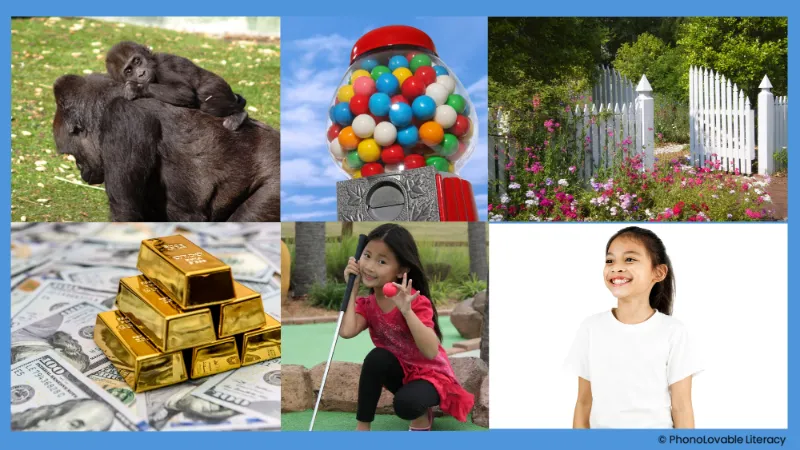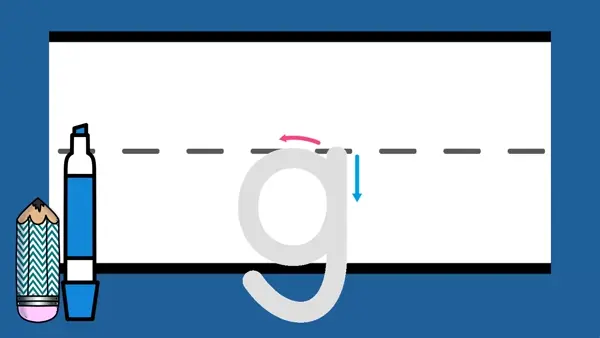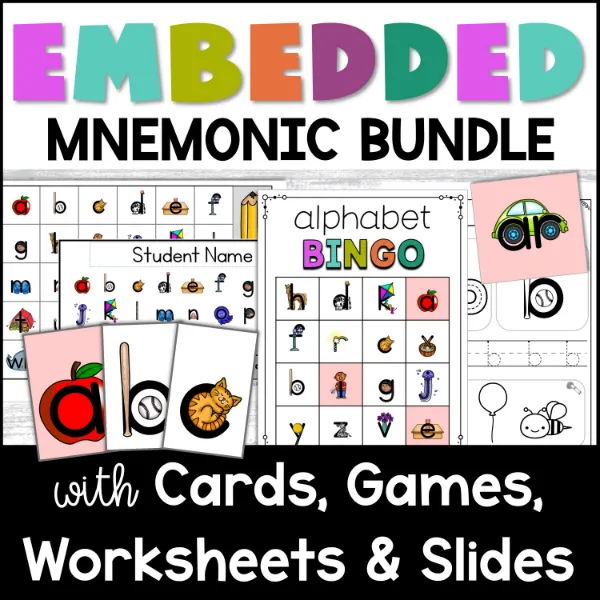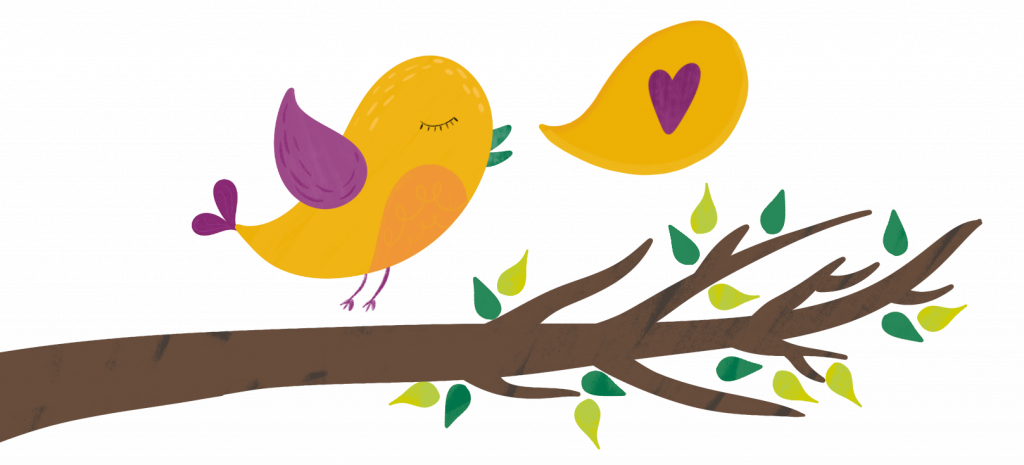Do you need a research-based routine for teaching letter g to preschoolers or kinders?
Are you getting the feeling that there could be a better way to introduce letter sounds, something more effective and engaging than what you have in your current program/curriculum?
If so, I’d love to share a simple, effective, and fun routine below. It’s based on solid reading research and something I’ve been using for years with wonderful results!
I used to show the printed letter g with a picture of a girl under the letter and say something like this:
“This is the letter g. G says /g/, as in girl. Repeat after me. G, girl, /g/.”
This worked okay I suppose. Most students eventually caught on. But there were too many students (especially when I started teaching students receiving special education and intervention services) that took too long to get it or would get it and lose it one day to the next.
So I found a better way! After years of diving into research studies and professional books, as well as every structured literacy training I could attend, I began making changes to my instructional routine of teaching letter sounds and have seen encouraging results.
Below, you’ll find a brief explanation of the steps I follow and why they’re effective. I hope I can provide something new for you to try when teaching the letter g to your preschoolers or kindergarten students. I’m rooting for you all!
Routine for Introducing the Letter G and Its Hard Sound
You can watch this video to get an idea of the entire routine. Feel free to show it to your students as well and let us do the work for you!
Start with speech.
Why?
We know that activating prior knowledge is an effective strategy to teach any new concept. It’s how we make new knowledge stick. So starting with spoken language, and even better- pairing it with visuals of things kids are interested in like gorillas, gold, and gum- allows students to build on existing knowledge and better connect new information like printed letters.
Since speaking comes naturally and reading does not, starting our instruction with something easy and familiar (talking!), and THEN connecting that speech to print, provides our children with a solid foundation for learning to read and write.


How?
Say 3-6 words that begin with the letter g, such as gorillas, gum, gate, gold, golf, and girl. Ask children to repeat each word (while you show images of the words if you can). Tell students that all of these words begin with the sound /g/. This is the “hard sound” of the letter g (as opposed to the “soft sound” which sounds like /j/ as in gym or giant).
Draw attention to your mouth when you make the /g/ (hard g) sound.
Why?
Helping students SEE and FEEL what happens when we make a certain sound helps add more meaningful associations between letters and sounds and makes an abstract concept a little more concrete.


How?
To make this sound, you need to press the back of your tongue to the back of your mouth. Model this for your students and/or show a sound articulation card (“mouth pic”) such as the one above. Tell students that they don’t need to open their mouths this wide, but it’s helpful to introduce the sound this way so they can see the elevation of the base of the tongue. This is hard to see with the jaw less open. The /g/ is a voiced sound, as opposed to the /k/ which is unvoiced. The mouth pics look the same, so I have students go back and forth a few times between making the /g/ and /k/ sounds, feeling their throat with the /g/ and feeling air come out of their mouth with the /k/.
Introduce the printed letter with an EMBEDDED mnemonic.
Why?
Research going back decades revealed that using embedded images, keyword pictures displayed within the letter as opposed to showing a picture separate from the letter, resulted in students improving both the acquisition AND retention of letter-sound correspondences. In fact, it was more effective and efficient than the other methods studied, such as using a keyword picture next to the letter, or using just a keyword for each letter (no pictures). What you’ll find in many phonics programs today are keyword pictures next to the letters, unfortunately, but embedded letters have definitely been making a comeback in the last few years!


How?
Here is where you’ll first show your students the actual letter. But not just a plain letter, an embedded letter. The image of a keyword such as girl embedded IN the letter helps solidify the connection between letter and sound. As pictured above, the shape of the girl’s head and her long braid corresponding to the shape of the lowercase letter g will serve as a reminder of the letter-sound relationship.
Model and practice how to write the letter.
Why?
Reading and writing are interrelated skills, and they should be taught together. As an interventionist who works with students from kindergarten to 4th grade, I’ve seen how hard it is to undo inefficient letter formation habits. For the past few years, I’ve made it a point to prioritize letter formation as early as possible. We teach phonemes and graphemes so that students may not only read new words, but learn to write them as well.


How?
I find most letter formation scrips in teacher’s guides to be unnecessarily wordy. I like to keep my language simple so students are more likely to memorize it. You may have different wording from a program you’ve used, or you may wish to change up how you say this, but here’s what I say as I model how to write the lowercase letter g. Since I’ve already taught my students how to write the letter c, I say this:
“Make a c. Push up to the middle line. Trace back down to curve around (below the bottom line and up towards the left).” I remind them that we never have to pick up our pencil. Once they understand these motions, I usually simplify my directions even further and say, “Start like a c. Turn it into a g” Or with my silly kinders, we sometimes joke “I’m making a c. Just kidding, it’s a g!”
I usually have students practice without a writing utensil a few times before I ask them to write with a dry-erase marker or pencil. This is just so I can make sure they’ve got the movements down or at least the letter-formation language before they put it on paper.
Research-Aligned Alphabet Resources
Need easy-to-use resources to implement the steps above?
Here are my recommendations for introducing the letter g and other letters to your preschoolers or kindergarten students:
Initial Sound Slides: These no-prep slides introduce each letter sound in the most effective and efficient way. With each click, you will show images of interesting photographs containing the beginning sound, a photo of a real kid making the sound along with a keyword image, the letter with an embedded mnemonic image, and lastly, an animated letter formation slide (one for uppercase and one for lowercase letters).
Mnemonic Alphabet Articulation Mouth Cards | Alphabet Posters with Real Pictures: If you prefer a paper option or don’t have access to digital resources, you may like these printable, 1-page posters of mouth pics along with the embedded mnemonic letters. It’s also a nice way to display the alphabet if you have classroom wall space.
Alphabet Picture Cards with Embedded Mnemonics: This set of printable pages comes with embedded letter cards in two sizes. Teach phonemes for 21 consonants, 5 short vowels, AND consonant digraphs WH, TH, SH, CH, and CK.
Looking for an “everything bundle” of embedded letter resources, including digital slides, letter cards, worksheets, games, and more? Get your students quickly and effectively mastering letter sounds so they can begin the even more exciting discovery of how to read and write words. Current savings are at nearly 50% off for all 12 resources!


Want a free set of small embedded letter cards? When you join us in our newsletter community, we’ll send you a complementary set as a thankyou gift.
Sources:
Ehri, L. C., Deffner, N. D., & Wilce, L. S. (1984). Pictorial mnemonics for phonics. Journal of Educational Psychology, 76(5), 880–893. https://doi.org/10.1037/0022-0663.76.5.880
Ehri, L. C. (2013). Orthographic Mapping in the Acquisition of Sight Word Reading, Spelling Memory, and Vocabulary Learning. Scientific Studies of Reading, 18(1), 5–21. https://doi.org/10.1080/10888438.2013.819356
Ehri, L.C. (2022). What Teachers Need to Know and Do to Teach Letter–Sounds, Phonemic Awareness, Word Reading, and Phonics. The Reading Teacher, 76(1), 53-61. https://doi.org/10.1002/trtr.2095
McNamara, G. (2012). The effectiveness of embedded picture mnemonic alphabet cards on letter recognition and letter sound knowledge. Theses and Dissertations. 302. https://rdw.rowan.edu/etd/302
Shmidman, A., & Ehri, L. (2010). Embedded Picture Mnemonics to Learn Letters. Scientific Studies of Reading, 14(2), 159–182. https://doi.org/10.1080/10888430903117492

